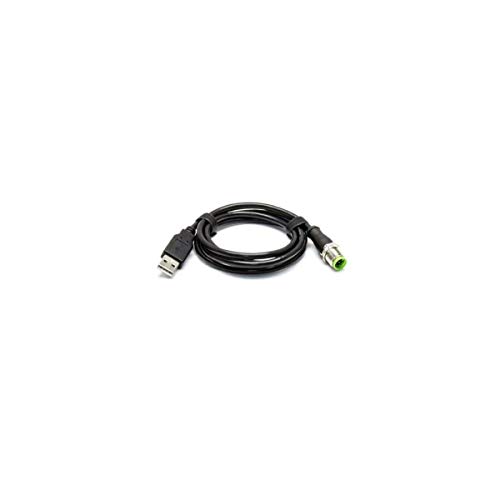In this article we are reviewing Nokta Anfibio Multi. This is a metal detector with three operation frequencies, which can work under water as well. The device can easily compete with top selling metal detectors, though it is not a rival to Minelab Equinox.
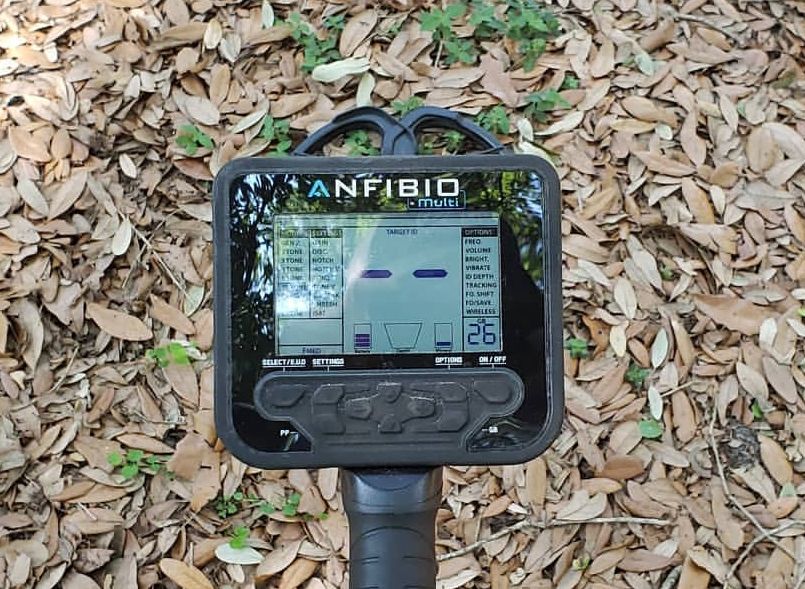
The Backstory
The family of Nokta Anfibio metal detectors appeared on the market it 2018. And it can be called a family, since it consists of three device models, which have similar appearance and characteristics.
All the metal detectors were manufactured in Turkey, since the manufacturing company is Turkish. However, it must be said, that the devices are rather high quality ones.
So, there are three models in the product line.
Nokta Makro Anfibio Multi
This is a metal detector with three operation frequencies, which makes it a multi-purpose device for treasure hunting, beach and coins hunting. Unlike other models of this product line, Nokta Makro Anfibio Multi works using three operation frequencies (5/14/20 kHz), not just one.
Notice, that they operate not simultaneously, but sequentially. This means that you can change the frequency according to the search conditions, but you can’t use them all at once.
This is what makes the device worse, than Minelab Equinox in this respect. You are welcome to read our review of the latter here.
- [ THE ULTIMATE BEGINNER’S CHOICE & EASY OPERATION ] Discover the FINDX metal…
- [ COMPLETE DETECTING SET ] FINDX Metal Detectors have everything you need while…
- [ LONG LASTING RECHARGEABLE LITHIUM BATTERY] FINDX, the best metal detector for…
Last update on 2024-07-07 / Affiliate links / Images from Amazon Product Advertising API / Source: Amazon Affiliates
| Operating Principle | VLF |
| Operating Frequency | 5kHz/14kHz/20kHz |
| Audio Frequencies | 150 Hz – 800Hz (adjustable) |
| Search Modes | 9 (GEN, 2 Tone, 3 Tone, 4 Tone, 5 Tone, 99 Tone, Beach, Deep, Cache) |
| Audio Tones | 5 |
| Tone Volume | Yes |
| Tone Break | Yes |
| Notch Filter | Yes |
| Notch Volume | Yes |
| Ground Balance | Automatic / Manual / Tracking |
| Pinpoint | Yes |
| Frequency Shift | Yes |
| Vibration | Yes |
| Gain Setting | 01-99 |
| Target ID | 00-99 |
| Search Coil | Waterproof DD Search Coil – 28 cm / 11″ (AF28) |
| Display | Custom LCD |
| Backlight | Yes |
| Keypad Backlight | Yes |
| Weight | 1.7 kg (3.7lbs.) including the search coil |
| Length | 76cm – 136cm (30″ – 53″) adjustable |
| Battery | 3700mAh Lithium Polymer |
| Warranty | 2 Years |
Nokta Makro Anfibio 14
This is a version of metal detector with one operation frequency equal to 14 kHz. This frequency is good for silver and small coins searching.
| Operating Principle | VLF |
| Operating Frequency | 14kHz |
| Audio Frequencies | 150 Hz – 800Hz (adjustable) |
| Search Modes | 8 (GEN, 2 Tone, 3 Tone, 4 Tone, 5 Tone, 99 Tone, Beach, Deep) |
| Audio Tones | 5 |
| Tone Volume | Yes |
| Tone Break | Yes |
| Notch Filter | Yes |
| Notch Volume | No |
| Ground Balance | Automatic / Manual / Tracking |
| Pinpoint | Yes |
| Frequency Shift | Yes |
| Vibration | Yes |
| Gain Setting | 01-99 |
| Target ID | 00-99 |
| Search Coil | Waterproof DD Search Coil – 28 cm / 11″ (AF28) |
| Display | Custom LCD |
| Backlight | Yes |
| Keypad Backlight | Yes |
| Weight | 1.7 kg (3.7lbs.) including the search coil |
| Length | 76cm – 136cm (30″ – 53″) adjustable |
| Battery | 3700mAh Lithium Polymer |
| Warranty | 2 Years |
Nokta Makro Anfibio 19
The device uses 19 kHz operation frequency and it is being promoted by manufacturers as a gold prospecting metal detector, namely, for jewelry hunting on the beach.
Though, the operation frequency of 19 kHz doesn’t penetrate into the ground deeper than 14 kHz, but it is more sensitive to small targets. For example, such complex targets as golden chains.
So, it seems to be rather complicated to divide these metal detectors in terms of their potential targets. But we can conveniently classify the devices as follows.
| Operating Principle | VLF |
| Operating Frequency | 19kHz |
| Audio Frequencies | 150 Hz – 800Hz (adjustable) |
| Search Modes | 5 (GEN, 2 Tone, 3 Tone, Deep, Cache) |
| Audio Tones | 3 |
| Tone Volume | No |
| Tone Break | Yes |
| Notch Filter | No |
| Notch Volume | No |
| Ground Balance | Automatic / Manual / Tracking |
| Pinpoint | Yes |
| Frequency Shift | Yes |
| Vibration | Yes |
| Gain Setting | 01-99 |
| Target ID | 00-99 |
| Search Coil | Waterproof DD Search Coil – 28 cm / 11″ (AF28) |
| Display | Custom LCD |
| Backlight | Yes |
| Keypad Backlight | Yes |
| Weight | 1.7 kg (3.7lbs.) including the search coil |
| Length | 76cm – 136cm (30″ – 53″) adjustable |
| Battery | 3700mAh Lithium Polymer |
| Warranty | 2 Years |
The first one is an all around metal detector, the second one is for gold prospecting and the third metal detector has three operation frequencies – 5, 14 and 20 kHz, which makes it a multi-purpose device.
Therefore, this device has all the functions and abilities of the first two plus the ability to work using the low operation frequency.
I didn’t quite get the marketing strategy of the company, since only one metal detector appeared to be interesting from all three devices.
And this is exactly what’s happened on the market. Nokta Anfibio Multi hasn’t become a sensation, but it is sold quite well on many markets (in Europe, for example). This is what we definitely can’t say about the rest two models with one operation frequency.
This metal detector has reminded me Nokta Impact, which I’ve used for quite a long time.
It’s no wonder, since Turkish manufacturers use one and the same basic design idea for all their metal detectors and we haven’t seen anything new in this respect yet.
The Review
Package set:
- Control unit;
- 11 DD coil (with protection);
- Wireless headphone;
- Charging and synchronization cables;
- BCB (battery charging board);
- Manual.
The device together with its accumulator and a standard coil weighs 1.7 kg or 3,75 pounds.
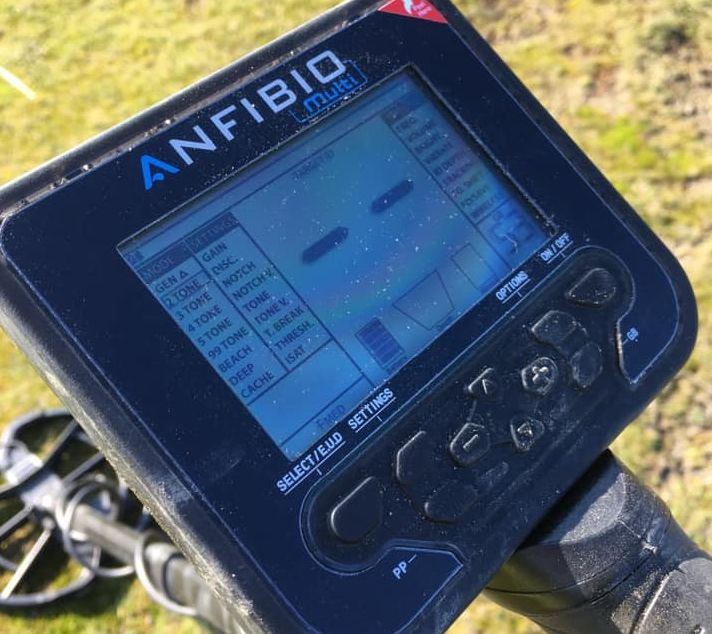
The Shaft
In general, the actual device looks like an improved and developed version of Racer or Impact.
If compared to Racer or Impact device models, Anfibio has more modern appearance. The battery unit has different design, the display box shape was changed a bit as well – all these make the metal detector look completely new.
As for the device design, it is the same as the one of any other metal detector. It consists of upper, middle and bottom shaft sections, a coil and a cable.
The upper shaft section is straight, not s-shaped; the device handle together with a display resemble upside down letter ‘T’.
There is an armrest on the upper shaft section and a power supply unit under it, a handle with a display and trigger as well as a LED to light the working area.
By the way, the trigger is designed to be very convenient to use, which I really enjoyed even when using Impact.
The shaft is assembled in the same way as it was for Impact and I must say that the process is handy, but not convenient. I considered the assembling process to be ok, until I started to use XP Deus with its amazing speed of assembly and disassembly.
Nokta Anfibio cable can’t be hidden inside the shaft, so it’s winded around it. Cable entries are sealed.
The shaft length can be adjusted in the range from 30 inches (76 cm) to 54.5 inches (136 cm) according to the user’s height. At the same time the armrest is smoothly adjusted as well and this allows perfect device balancing.
Why should you care about the metal detector balance? Just to make sure that you and your hands get less tired. Most of other metal detectors are not well balanced and they don’t have wide adjustment range of their shaft or armrest.
If you use various coils (of different weight), there is no point to speak about the device balance at all. In such cases your hand is compensating the device balance.
The Coil
The basic coil of Nokta Anfibio Multi is Nokta 11 DD (AF28 DD). This is a large round coil of DoubleD type 11 inches in diameter.
The coil is light weighted and sensitive to small targets. It provides high detection depth and a plastic protection case comes in the device set.
What other coils will do for Nokta Anfibio Multi?
Besides the standard coils made by the original manufacturer (for Nokta Anfibio Multi you can find 7 branded coils from very small sized to large ones), there are also coils produced by off-brand manufacturers such as Nel and Detech.
They are much more interesting than those produced by Nokta. Firstly, they offer a wide selection of coils for all kinds of treasure hunting. Secondly, these coils are significantly cheaper.
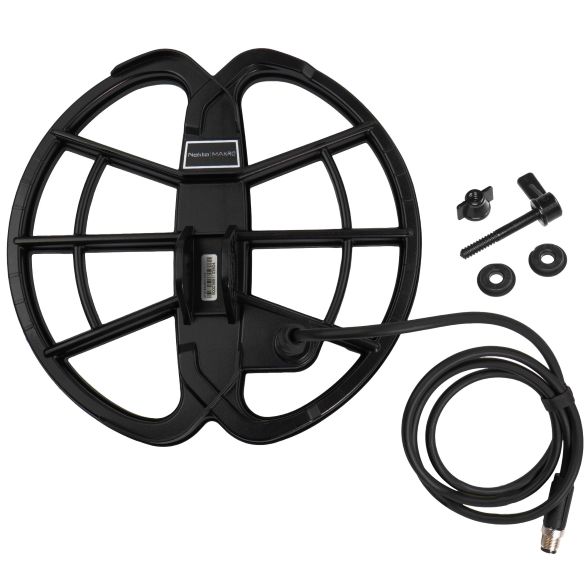
Headphones
Let’s note, that the device package set contains wireless headphones and it will work with any model of wireless headphones made by Makro and Nokta.
The device supports two types of headphones – wireless and wired ones. The jack for wired headphones is water-resistant (regardless of the metal detector type).
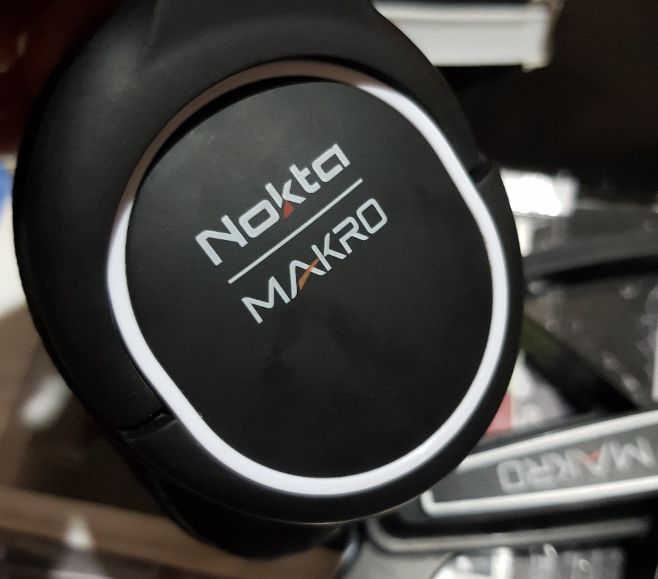
Wireless headphones for Nokta Anfibio Multi don’t require a transmitter, since this module is already embedded in the metal detector.
The target signal in these headphones is received in the real-time scale without any delays, which makes them rather helpful and convenient for the treasure hunting process.
The target signal is more informative than the sound received from the embedded speaker. When you are working using the headphones, it gives you the advantage while searching for very small and rather deeply located targets.
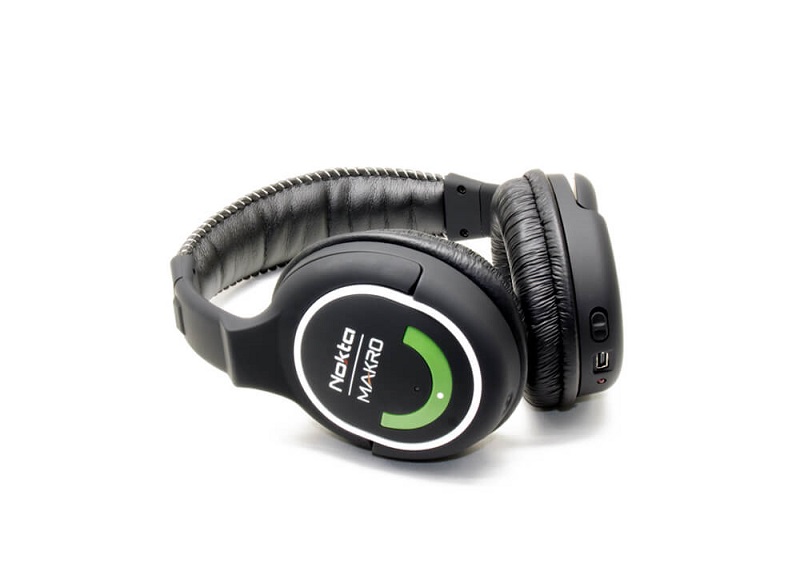
Waterproof
All other device constituents are also sealed. The manufacturer says that complete submerge of the device is possible. The submerge depth limit is stated to be 5 meters deep.
First of all, this device is an amphibian metal detector, which is clear from its name. Except standard ground search, it is allowed to submerge the device up to 5 meters (16.4ft.) deep. The metal detector has IP68 protection grade.
This advantage works not only for underwater treasure hunting, since it also enables dirt and dust protection, searching under the rain and washing the device under running water.
In such situations owners of ordinary ground metal detectors risk their devices a lot, while you will just enjoy the process with a high quality waterproof device.
The device speaker is also completely waterproof.
All the control buttons of the metal detector are hidden under rubberized cover, so there is no moisture or dust ingress there.
Power Supply
Another large merit of Nokta Anfibio Multi is an embedded 3600 mAh Li-Pol accumulator battery. At that, you can charge the device using standard USB charging cable or a powerbank.
If required, you can install an additional accumulator battery (powerbank). Branded Nokta powerbank and the jack for switching it are both water-resistant.
In the bottom of the device armrest there is a special holder for it.
Frequencies Changing
Nokta Anfibio Multi main feature is its ability to change operation frequencies. For example, 14 kHz frequency is good for coins and relics hunting.
To detect large and deeply located targets 4-5 kHz operation frequency should be used.
Jewelry and very small sized targets are better detected when using 18-20 kHz frequency.
If you’ve found your target at some specific place, you should definitely scan it using different operation frequencies. This way you’ll be 100 percent sure that there’s nothing valuable left behind.
Nokta Anfibio Multi gives you a choice which of three available operation frequencies to use – 5 kHz, 14 kHz and 20 kHz. With such a set of the frequencies you are ready to detect any types of targets. But this is not all!
Settings
Nokta Anfibio Multi has 9 search modes including special modes for beach hunting and high depth search mode. The device users say, that all the device basic settings look similar to the ones of Makro device, the Kruzer model.
Ability to change search modes together with the selected operation frequency allows the device user to detect the target with the highest precision. After using Nokta Anfibio Multi there are no valuable targets left in the ground.
The metal detector settings depend on the search mode. For example, Cache search mode has no possibility of discrimination adjustment. In ‘99’ search mode there is no Tone Break, since it’d be rather tiring to adjust it for all 99 VDI.
We should also mention such setting as a frequency shift. It allows to damp noises from other devices using the same frequency and working in the neighborhood at the same time.
General Search Modes (GEN and GEN Delta)
This is a common static search mode without discrimination and a single tone signal. The mode is good for searching in fields with very little iron rubbish, where you can dig each detected target.
Tone Discrimination (2 TONE)
The search mode with target discrimination and the Tone Break Threshold adjustment within the range from 15 to 20 units of the scale provides sufficient detection depth.
Tone Discrimination (3 TONE)
This mode has adjustable discrimination function with three tone target signal. The recovery time essentially differs for range of response before 89 and within 90-99.
Thus, here are the following recommendations: sensitivity should be up to 89 at areas littered with rubbish and higher on the clean ground.
Tone Discrimination (4TONE)
This is a very sensitive and noisy mode. It is applicable for standard ground search and it perfectly deals with it.
Tone Discrimination (5 TONE)
The search depth isn’t the most significant one here, but the search mode itself is quite stable and quiet.
99 Tone Discrimination (DI99)
Polyphony allows detecting the target type by ear, which can be quite useful. For example, it enables to see between some foil with high VDI number and valuable target.
Beach Mode (BEACH)
This is a search mode with a pre-set discrimination for beach hunting. It’s not very noisy and it works even for wet ground, the type of water doesn’t matter in this case.
Deep Mode (DEEP)
The recovery level in this mode isn’t quite high, it assumes slow coil movements to get maximum detection depth.
Cache Mode (CACHE)
A static mode for detection of large targets up to 1 meter deep. This search mode was meant for large ferrous metals targets detection. Keep the coil higher and you won’t see any small targets. The best results are obtained using 5 kHz operation frequency.
First, let’s consider characteristics of both metal detectors.
They both are equipped with similar coils, they can work under water, use an embedded accumulator battery, their package set contains wireless headphones as well as provides their users with all necessary functions.
Though, there are some differences. The main one is that Nokta Anfibio can use one of the selected operational frequencies, while Minelab Equinox can also use several operation frequencies simultaneously.
Besides, Minelab Equinox 800 offers wider range of operation frequencies to select from and it can work even using 40 kHz frequency.
At the same time, we can mention the following advantage of Anfibio: due to the larger range of the target identification scale, Anfibio enables more precise detection of what exactly you have under the device coil. So, if you want to distinguish targets precisely Anfibio is definitely worth buying.
If you are interested in searching for non-ferrous targets, Equinox will be quite enough for this purpose.
We’d also like to mention, that if you start digging all non-ferrous targets you detect, you’ll have more valuable findings, since you will hardly ever get precise VDI in the areas full of ferrous rubbish.
Pros
- Water-resisting properties IP 68 mean not only its ability to work under the rain, but also to submerge the device.
- The metal detector is quite fast with good target distinguishing.
- It has convenient and informative display.
- Wireless headphones come in the device set.
- Tone Break Threshold changes for ferrous/non-ferrous signals
- Perfect combination of parameters for all occasions
Cons
- Noisy, especially in case of certain discrimination programs
Conclusions
Anfibio Multi is quite interesting and a multi-purpose metal detector, which can work at any search conditions: whether it is a park, a field, a beach or even underwater treasure hunting. If I had to choose between Anfibio Multi and Minelab Equinox, I would choose Minelab.
It’s undeniable advantage is that it uses several operation frequencies simultaneously and Australian manufacturers yet have better technologies for now. However, each time the Turkish company designs more and more interesting metal detectors.
Therefore, if I had to choose between Anfibio Multi and Garrett ACE 400, the latter wouldn’t have any chance to win.
